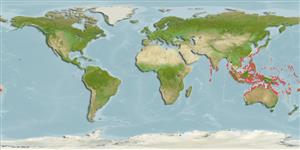>
Eupercaria/misc (Various families in series Eupercaria) >
Labridae (Wrasses) > Corinae
Etymology: Thalassoma: Greek, thalassa = the sea + Greek, soma = body; the colour of the sea (Ref. 45335).
More on author: Bleeker.
Environment: milieu / climate zone / depth range / distribution range
Ecologia
marinhas associadas(os) a recifes; não migratória; intervalo de profundidade 1 - 15 m (Ref. 1602), usually 1 - 12 m (Ref. 27115). Tropical; 24°C - 28°C (Ref. 27115); 35°N - 47°S, 70°E - 175°W
Indo-West Pacific: Maldives to Fiji, north to southern Japan, south to Lord Howe Island.
Tamanho / Peso / Idade
Maturity: Lm ? range ? - ? cm
Max length : 20.0 cm TL macho/indeterminado; (Ref. 9710)
Espinhos dorsais (total) : 8; Raios dorsais (total) : 13; Espinhos anais: 3; Raios anais : 11. Color pattern remains similar throughout life. Large juveniles and females are mostly black with a single white band and white area below the head to the anus. Males retain the white central band but is more yellow, and develops a second narrow band halfway towards the head (Ref. 48636). Initial phase white with 3 black bars, the first on upper half of head and anterior body containing a yellow streak at edge of opercle, the second across dorsal fin and ventrally to anus, the third covering most of body and posterior portions of dorsal and anal fins. Terminal male with yellow between black bars. Pectoral fins bluish (Ref 9823).
Occurs in groups (Ref. 90102) in exposed crests of seaward and lagoon reefs, usually rock-based. Minimum depth reported from Ref. 27115. Replaced by T. nigrofascatum in Papua New Guinea (Ref. 90102).
Ciclo de vida ou comportamento de acasalamento
Maturities | Reprodução | Spawnings | Egg(s) | Fecundities | Larvas
Oviparous, distinct pairing during breeding (Ref. 205).
Randall, J.E., G.R. Allen and R.C. Steene, 1990. Fishes of the Great Barrier Reef and Coral Sea. University of Hawaii Press, Honolulu, Hawaii. 506 p. (Ref. 2334)
Status na Lista Vermelha da UICN (Ref. 130435)
Ameaça para os humanos
Harmless
Uso pelos humanos
Pescarias: espécies comerciais; Aquário: Espécies comerciais
Ferramentas
Relatórios especiais
Baixar XML
Fontes da internet
Estimates based on models
Preferred temperature (Ref.
123201): 23.6 - 29.3, mean 28.6 °C (based on 2503 cells).
Índice de diversidade filogenética (Ref.
82804): PD
50 = 0.5000 [Uniqueness, from 0.5 = low to 2.0 = high].
Bayesian length-weight: a=0.00955 (0.00430 - 0.02123), b=3.06 (2.89 - 3.23), in cm total length, based on LWR estimates for this Genus-body shape (Ref.
93245).
Nível Trófico (Ref.
69278): 3.1 ±0.2 se; based on diet studies.
Resiliência (Ref.
120179): médio(a), tempo mínimo de duplicação da população 1,4 - 4,4 anos (Preliminary K or Fecundity.).
Fishing Vulnerability (Ref.
59153): Low vulnerability (10 of 100).
Nutrients (Ref.
124155): Calcium = 77.9 [45.6, 128.6] mg/100g; Iron = 0.684 [0.398, 1.279] mg/100g; Protein = 18.4 [15.5, 20.6] %; Omega3 = 0.133 [0.085, 0.204] g/100g; Selenium = 21.7 [13.3, 38.4] μg/100g; VitaminA = 126 [39, 461] μg/100g; Zinc = 1.74 [1.23, 2.83] mg/100g (wet weight);
